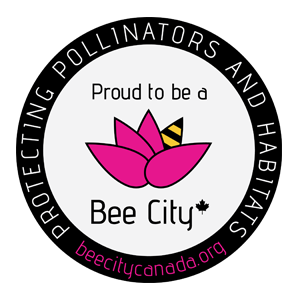Okotoks aspires to be innovative and resilient, balancing community expectations with impacts to the environment. In 2008, Okotoks led the initiative of utilizing weed threshold levels to justify spraying, allowing for some tolerance of weeds in parks and open spaces. The Town’s Integrated Pest Management Plan was again updated in 2016 and reflects all our current practices for the management of weeds and pests on public lands.
Herbicide:

Manicured turf areas are treated with herbicide by certified pesticide applicators only where total weed coverage exceeds 15% in park areas, 5% in sports fields and high profile sites. In 2016, the Town asked residents through its Conservation Educator Program whether they supported this practice. Of the 408 residents they asked, 327 (80%) were in support. Since incorporating threshold weed spraying other municipalities have followed suit.
As dandelions are considered a “nuisance” weed due to its stronghold across North America, control is the only expected outcome and eradication not currently possible. However, by controlling weeds on public lands, homeowners have less of a need to purchase and apply these chemicals themselves. Where citizens wish to not have herbicide utilized in their neighbourhood park, the Integrated Pest Management Plan makes a provision for that requiring neighbourhood support on that decision.
In Okotoks, water conservation is a priority and most parks and open spaces are non-irrigated, except for sports fields. Lack of irrigation coupled with generally low precipitation prevents turf from being able to outcompete weed species such as dandelions.
Pollinators:

The Town acknowledges the importance of pollinators and does not use neonicotinoids, the pesticide family that has been determined to contribute to increased bee mortality. Although dandelions do provide early food for pollinators, there are a number of other early bloomers that assist here such as buffalo bean, Saskatoon berry, poplar, native willow, aspen, and Canada buffaloberry. These species are abundant in our natural areas including the river valley of which comprise over 260 hectares within our Town boundary, exceeding the land area of manicured turf on public lands.
As a Bee City, the Town has a number of new initiatives underway to improve pollinator habitat. Where some narrow or steep turf areas exist, the Town has replaced traditional turf with a combination of pollinator friendly plants and ornamental grasses. These plantings not only improve the aesthetics, but eliminate the need for mowing and herbicide use. Some examples of areas where this has been undertaken include Sheep River Boulevard, Southridge Emergency Services site, Operations Centre, Crystal Green Drive median, and the Big Rock Trail median. In 2017, many pollinator plants were incorporated into the re-landscaping of Veterans Way. We will be expanding this initiative by incorporating these practices into new subdivision areas. Residents can also get authorization from the Town to convert turf boulevards adjacent their property to mulches or alternate groundcovers in a similar fashion.
The Town of Okotoks will continue to be proactive and innovative in our design, maintenance, and management of public lands to develop a resilient and beautiful community. Okotoks continually reviews best practices and looks for opportunities and innovative ways to reduce any impacts to the environment.
 As a bee-friendly community, the Town recognizes the importance of pollinators & does not apply insecticides, fungicides, or the pesticide that has been determined to contribute to increased bee mortality. Okotoks also has over 325 hectares of natural areas, including the river valley, that are abundant with species that support pollinators such as buffalo bean, Saskatoon berry, poplar, native willow, aspen & Canada buffaloberry! The Town also has initiatives underway to improve the pollinator habitat like replacing traditional turf with a combination of pollinator- friendly plants & ornamental grasses in many areas including Sheep River Blvd, Crystal Green Dr median, Big Rock Tr median & Veterans Way. As a leader in sustainability, the Town seeks to balance community expectations with environmental impacts & is proactive & innovative in our design, maintenance & management of public lands to maintain a sustainable community.
As a bee-friendly community, the Town recognizes the importance of pollinators & does not apply insecticides, fungicides, or the pesticide that has been determined to contribute to increased bee mortality. Okotoks also has over 325 hectares of natural areas, including the river valley, that are abundant with species that support pollinators such as buffalo bean, Saskatoon berry, poplar, native willow, aspen & Canada buffaloberry! The Town also has initiatives underway to improve the pollinator habitat like replacing traditional turf with a combination of pollinator- friendly plants & ornamental grasses in many areas including Sheep River Blvd, Crystal Green Dr median, Big Rock Tr median & Veterans Way. As a leader in sustainability, the Town seeks to balance community expectations with environmental impacts & is proactive & innovative in our design, maintenance & management of public lands to maintain a sustainable community.


